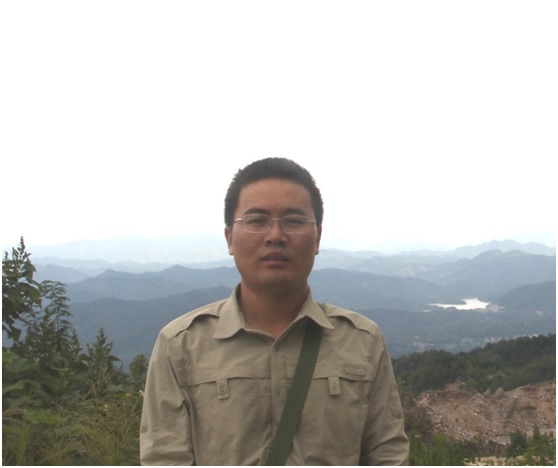刘向冲研究员
发布时间:2023-04-24

刘向冲,男,1987年,博士学位,研究员,硕士生导师。研究领域主要包括热液型矿床、地震等固体地球领域的流体-热-变形-化学多场多尺度耦合过程与计算模拟、成分数据分析与解释、统计分形等,目前承担和参与的项目主要涉及钨、锡、金、锑等热液矿床成因、流体与地震孕育关系等,以第一作者或通讯作者身份发表22篇论文,其中15篇SCI论文,相关代表性成果发表在《Geochimica et Cosmochimica Acta》、《Geoscience Frontiers》、《Chemical Geology》、《Tectonophysics》、《Ore Geology Reviews》、《Journal of Geochemical Exploration》等相关领域的权威SCI期刊。
主要学术成果:
1. 钨、锡成矿作用是速率控制的(即与时间相关),因而岩浆超固相线时限至关重要。较高的放射性生热率、随岩浆演化逐渐降低固相线温度、中等的热传导速率可大幅延长高产热花岗岩的超固相线时限,显著提高热液从成矿母岩提取钨、锡的总质量,这将提高钨、锡成矿(尤其是成大矿)的概率。因而世界级钨锡矿与高产热花岗岩共存不是偶然的。
2. 在大部分钨成矿条件下,白钨矿的溶解度高于钨铁矿和钨锰矿的溶解度;识别出白钨矿交代钨铁矿或钨锰矿的两种机制:第一种机制是降温且热液中Ca/Fe(或Ca/Mn)比值升高;第二种机制是热液中Ca/Fe(或Ca/Mn)比值不变的情况下降压。第二种机制可能是成矿热液在比较贫Ca围岩(相对于碳酸盐)中依然沉淀出白钨矿的一个重要原因。
3. 通过梳理相关组分近50年的热力学数据,分别建立了钨锰矿和钨铁矿在NaCl-H2O体系的平衡反应热力学模型,给出了黑钨矿两个端元(钨锰矿和钨铁矿)的有效沉淀机制,填补了钨锰矿溶解度理论计算的空白。
4. 深部高压流体侵位会使上地壳(6-10公里深)流体密度升高,在10年内产生重力场正异常。其中,流体压力是产生重力场变化的主要变量。深部高压流体侵位后的最初2-3年重力场变化速率非常快(>3 微伽/年),之后重力场的变化快速减小;流体侵位的最初1-3年是最佳的观测窗口,因而有必要提高重力观测的频率至≥1次/年。
5. 根据西藏多龙地区斑岩型铜金矿床的地质与地球化学特征,发现一种地质知识驱动对数变换方法,化探元素经该方法变换后有明确的地质意义,并在认识多龙地区地质过程和找矿预测取得良好效果。
6. 南岭地区石英脉型黑钨矿床“五层楼”垂直形态分带的CL显微结构显示,脉体虽是多次热液活动累积形成的,但脉体形态分带在成矿早期已具雏形;这种脉体分带与成矿热液在容矿裂隙的聚焦流动水平有关。
代表论文及著作:
1.Liu, X.C., Zhang, D., Yang, J., Xiao, C., Zhang, T., 2023. High heat producing granites and prolonged extraction of tungsten and tin from melts. Geochimica et Cosmochimica Acta, 348: 340-354.
2.Liu, X.C., Yu, P.P., Xiao, C.H. 2023. Tin transport and cassiterite precipitation from hydrothermal fluids. Geoscience Frontiers, 101624.
3.Liu, X.C., Chen, S., Xing, H., 2022. Gravity changes caused by crustal fluids invasion: A perspective from finite element modeling. Tectonophysics, 833: 229335.
4.Liu, X.C., Xiao, C.H., Wang, Y., 2021. The relative solubilities of wolframite and scheelite in hydrothermal fluids: Insights from thermodynamic modeling. Chemical Geology, 584(4): 120488.
5.Liu, X.C., Wang, W., Zhang, D., 2021. The mechanisms forming the five–floor zonation of quartz veins: a case study in the Piaotang tungsten–tin deposit, Southern China. Minerals, 11(8): 883.
6.Liu, X.C., Xiao, C., Zhang, S., Chen, B., 2021. Numerical Modeling of Deformation at the Baiyun Gold Deposit, Northeastern China: Insights into the Structural Controls on Mineralization. Journal of Earth Science, 32(1): 174-184.
7.Liu, X.C., Xiao, C.H., 2020. Wolframite solubility and precipitation in hydrothermal fluids: Insight from thermodynamic modeling. Ore Geology Reviews, 117: 103289.
8.Liu, X.C., Wang, W., Pei, Y., Yu, P., 2020. A knowledge-driven way to interpret the isometric log-ratio transformation and mixture distributions of geochemical data. Journal of Geochemical Exploration, 210: 106417.
9.Liu, X.C., Ma, Y., Xing, H., Zhang, D., 2018. Chemical responses to hydraulic fracturing and wolframite deposition in the vein-type tungsten deposits, southern China. Ore Geology Reviews, 102: 44-58.
10.Liu, X.C., Xing, H., Zhang, D., 2018. Hydraulic Fracturing Leads to Wolframite Deposition at Magmatic‐hydrothermal transition. Acta Geologica Sinica - English Edition, 92(2): 862-863.
11.Liu, X.C, Xing, H., Zhang, D., 2017. The mechanisms and time scale of alteration halos in vein-type tungsten deposits in southern China. Ore Geology Reviews, 89: 1019-1029.
12.Liu, X.C., Xing, H., Zhang, D., 2017. Influences of hydraulic fracturing on fluid flow and mineralization at the vein-type tungsten deposits in southern China. Geofluids: 11.
13.Liu, X.C., Xing, H., Zhang, D., 2016. Influences of fluid properties on the hydrothermal fluid flow and alteration halos at the Dajishan tungsten deposit, China. Journal of Geochemica Exploration, 163: 53-69.
14.Liu, X.C, Xing, H., Zhang, D., 2015. The mechanisms of the infill textures and its implications for the five-floor zonation at the Dajishan vein-type tungsten deposit, China. Ore Geology Reviews. 65(1):365-374.
15.Liu, X.C., Xing, H., Zhang, D., 2014. Fluid focusing and its link to vertical morphological zonation at the Dajishan vein-type tungsten deposit, South China. Ore Geology Reviews, 62(1): 245-258.
16.刘向冲,肖昌浩,胡国辉,李建锋,王晨光,张拴宏, 2020. 辽东三股流岩体是否为五龙金矿成矿提供必要的能量?. 地球科学, 45(11): 3998-4013.
17.王晨光,张德会,刘向冲*,肖昌浩. 2023. 广西德保矽卡岩型铜锡矿床成矿流体演化特征. 高校地质学报,29(2):175-186.
18.刘向冲,邢会林,张德会, 2019. 华南南岭地区石英脉型钨矿床蚀变晕形成机制. 地质通报, 38(9): 1556-1563.
19.刘向冲, 张德会, 2019. 黑钨矿有效沉淀机制:CO2 逃逸. 地质力学学报, 25(1): 19-26.
20.刘向冲,张德会,赵波,廖泽忠,刘才平, 2017. 漂塘钨矿床“五层楼”垂直形态分带定量分析. 高校地质学报, 23(3): 408-416.
21.刘向冲,王文磊,裴英茹, 2017. 西藏多龙矿集区水系沉积物地球化学数据定量分析与解释. 地质力学学报, 23(5): 695-706.
22.刘向冲,候翠霞,申维,张德会.MML—EM方法及其在化探数据混合分布中的应用.地球科学-中国地质大学.2011,36(2),355-359.
主要承担的项目:
1.中国地质调查局项目:右江锡锑金多金属区块优选调查评价,2023.1-2025.12,副负责.
2.国家自然科学基金—中国地震局地震科学联合重点基金:逆冲构造背景下的强震孕育发生过程与前兆机理研究,2020.1-2023.12,在研,流体数值模拟课题负责人.
3.国家重点研发计划:华北克拉通辽东中生代金多金属矿深部探测及增储勘查示范,2018.1-2021.6,在研,构造-流体数值模拟专题负责人.
4.中国黄金集团资源有限公司资助项目:高产热花岗岩浆侵位后流体动力学数值模拟,2018.6-2020.6,在研,主持.
5.国家自然科学基金青年基金:石英脉型黑钨矿床热液运移模拟与黑钨矿沉淀机制,2017.1-2019.12,已结题,主持.
6.地质过程与矿产资源国家重点实验室资助的开放课题:成矿流体流动模式与 脉状钨矿砂包的关系,2012.6-2013.12,已结题,主持.
7.中国地质调查局项目:右江成矿带锡金多金属矿集区矿田构造调查与找矿预测,2019.1-2021.12,在研,参与.
8.国家自然科学基金面上项目:石英脉型黑钨矿床“五层楼”垂直形态分带形成 的动力学机制,2014.1-2017.12, 已结题,参与.
9.中国地质调查局项目:班公湖-怒江成矿带铜多金属矿资源基地调查,2016.1-2018.12,已结题,参与.
联系方式:xcliu@cags.ac.cn或liuxiangchong1987@163.com

 京公网安备 11010202007433号
京公网安备 11010202007433号